

MOOC. Modalités de formation au tutorat à distance - Etude Comparative - frantice.net. Modalities of training for distance tutoring - Comparative Study Date de publication : 13 juillet 2010 Auteur(s) Besma Ben Salah Jemli, Institut Supérieur des Etudes Technologiques (ISET), Sousse, Tunisie Résumé L’enseignement et la formation sont en pleine mutation dictée par de nouvelles offres, de nouveaux objectifs mais aussi par l’élan des TIC.
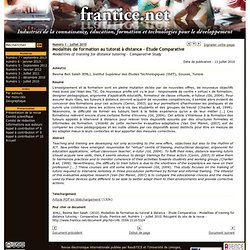
Abstract Teaching and training are developing not only according to the new offers, objectives but also to the rhythm of ICT. Téléchargement Pour citer ce document. CEMAFORAD4 Strasbourg 2008. ACTES DE CEMAFORAD4 Strasbourg 2008 Les objectifs du Colloque sont de faire le point sur le développement de la formation à distance en Europe, dans les pays du pourtour méditerranéen ainsi qu'en Afrique, tout en contribuant à sa structuration.
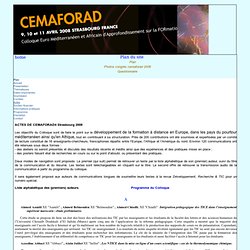
Près de 200 contributions ont été soumises et expertisées par un comité de lecture constitué de 16 enseignants-chercheurs, francophones répartis entre l'Europe, l'Afrique et l'Amérique du nord. Environ 120 communications ont été retenues sous deux formes : - des ateliers où seront présentés et discutés des résultats récents et inédits ainsi que des expériences et des pratiques mises en place ; - des posters faisant état de recherches en cours ou sur le point d'aboutir, ou présentant des pratiques.
Deux modes de navigation sont proposés. (99+) eduMOOC. EduMOOC: Online Learning Today... and Tomorrow. Program and Resources Expanding Daily!

Visit Often for Updates! The gadget spec URL could not be found The Center for Online Learning, Research and Service at the University of Illinois Springfield welcomes you to a Massive Open Online Class (MOOC) on “Online Learning Today...and Tomorrow.” It will continue through August 19. It is totally open, free, and collaborative. You are invited to register (see right column) with only your name and email address so you can be given access to all materials, panels and discussions.
Enrollment Update! We are elated to see enormous interest in this topic! We will add all who register to the Google Group in daily uploads. The MOOC Guide. The purpose of this document is two-fold: - to offer an online history of the development of the Massive Open Online Course (MOOC) - to use that history to describe major elements of a MOOC Each chapter of this guide looks at one of the first MOOCs and some early influences.

It contains these parts: - a description of the MOOC, what it did, and what was learned - a description of the element of MOOC theory learned in the offering of the course - practical tools that can be used to develop that aspect of a MOOC - practical tips on how to be successful. MoocGuide - 0. Home Intro to MOOC. MOOGCOOKTIPS - home. MoocGuide - 9. References. Fini A. (2009).
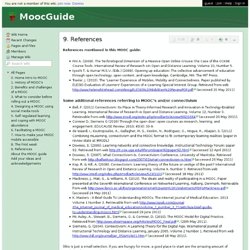
The Technological Dimension of a Massive Open Online Crouse: the Case of the CCK08 Course Tools. International Review of Research oin Open and Distance Learning. OpenID Foundation website. Creative Commons. 25 Tips to Make the Most of a MOOC. Massive online open courses (also known as MOOCs) are quite popular these days.

A huge, or massive, version of open online courses, these classes bring thousands together, often around the world, to learn simultaneously. Discussions, connections, and learning are the focus on MOOCs, but with the low level of commitment and their overwhelming nature, it’s easy to get disconnected. Read on, and we’ll share 25 ways to stay in the loop, on task, and get the most out of your MOOC experience. Le connectivisme, ou le lien comme principe de base d’apprentissage (CCK11/1)
Voici deux semaines maintenant, je me suis inscrite à un MOOC.
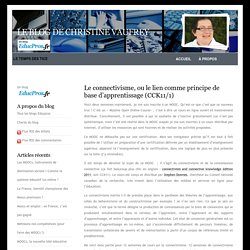
Qu’est-ce que c’est que ce nouveau truc ? C’est un « Massive Open Online Course« , c’est à dire un cours en ligne ouvert et massivement distribué. Concrètement, il est possible à qui le souhaite de s’inscrire gratuitement (ce n’est pas systématique, mais c’est une réalité dans le MOOC auquel je me suis inscrite) à un cours distribué par Internet, d’utiliser les ressources qui sont fournies et de réaliser les activités proposées. #CCK11 - Connectivism & Connective Knowledge in Action! Click here to read my experience participating in PLENK 2010, which was also conducted by Stephen and George.
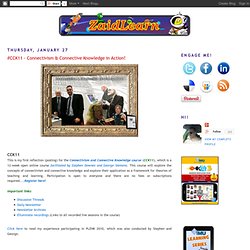
"At its heart, connectivism is the thesis that knowledge is distributed across a network of connections, and therefore that learning consists of the ability to construct and traverse those networks. It shares with some other theories a core proposition, that knowledge is not acquired, as though it were a thing. Knowledge is, on this theory, literally the set of connections formed by actions and experience.
Virtual=Real. eLearning. E-Learning: Générations. (English version) Ces dernières années, j'ai travaillé sur deux grands concepts: d'abord, la théorie de l'apprentissage en ligne connectivist, qui considère l'apprentissage comme un processus de réseau et, deuxièmement, le massif cours ouverts en ligne, ou MOOC, qui est une instanciation de ce processus.

Ceux-ci, cependant, ne représentent que la plus récente de ce qui peut être vu comme une série de «générations» de e-learning. Dans cet exposé, je décris ces générations et je discute de la façon dont ils ont conduit à, et sont une partie de, l'œuvre le plus récente dans l'apprentissage en ligne. Merci de m'accueillir á votre conférence. The model in action. Throughout 2011 we will be publishing extracts from The New Learning Architect.

We move on to the eighth and final part of chapter 4: A multitude of opportunities for increasing learning exists within every context, both from the top down and bottom up. The table above shows just a sample of what is available. Some of these opportunities are certainly not new, but may not have been fully exploited in the past. Others – such as blogging, electronic performance support, online books, mobile learning, using forums and wikis, online search, podcasts and webcasts, social networking and blended learning – have resulted from relatively recent technological developments, and have certainly not yet been used to their full potential.
Social Media, Google + and the Golden Eggs with MOOC. What is social media, Google + and technology’s role in MOOC? What sort of MOOC model would be useful for online learning? Is MOOC suited for the education and learning of any subjects and topics? Théories 1, réflexions, méthodes, FLE et Internet. Roots of Connectivism. Connectivism and Connective Knowledge. Connectivism_Online. Connectivism. Connectivism: A Learning Theory for the Digital Age. Connectivism: A Learning Theory for the Digital Age December 12, 2004 George Siemens Update (April 5, 2005): I've added a website to explore this concept at www.connectivism.ca Introduction Behaviorism, cognitivism, and constructivism are the three broad learning theories most often utilized in the creation of instructional environments.
Constructivisme, socioconstructivisme et connectivisme. L’éditeur, ce n’est pas celui qui dompte la bête, c’est celui qui la socialise. (Christine Angot) Par souci d’individualisation et de métacognition des apprentissages, je résiste à la tentation d’obliger les élèves à utiliser leur blogue scolaire. Je mise plutôt sur des facteurs de motivation tels que la perception de valeur, de compétence et de contrôlabilité. Je ne manque donc jamais une occasion en début d’année de souligner aux élèves l’importance des nouvelles technologies dans l’apprentissage et l’optimisation de leur avenir. Je sais très bien que la première question, au moment de la présentation des blogues, sera « à quoi ça va me servir? Www.elearnspace.org/KnowingKnowledge_LowRes.pdf.
Networked Student. Groups and Networks. Connectivism & Open Learning. George Siemens - Connectivism: Socializing Open Learning. Knowledge Brokering. UNESCO. Connectivisme: Socialising Open Learning. xNYED - George Siemens - 03/06/10. El conectivismo como teoría de aprendizaje emergente. Explore a New Learning Frontier: MOOCs by Inge de Waard. “As educational technology is becoming more mainstream through social media and mobile devices, there is a rising interest to find methodologies that build upon these new technologies to enhance the learning and teaching process. MOOC is one of these emerging formats. A MOOC can boost your institutional, corporate, or NGO knowledge, if you are open to its innovative approach.” A MOOC is a Massive Open Online Course.
It is a gathering of participants, of people willing to jointly exchange information and collaboratively enhance their knowledge. Over 10,000 learners worldwide have participated in MOOCs on a variety of topics. MOOCs fit the contemporary shift towards networked learning. Use of educational technology is becoming more mainstream through social media and mobile devices. MOOCs are organized on the Internet. Revue sticef.org. SmkbMOOC.pdf. RITPU_v07_n02_48.pdf.